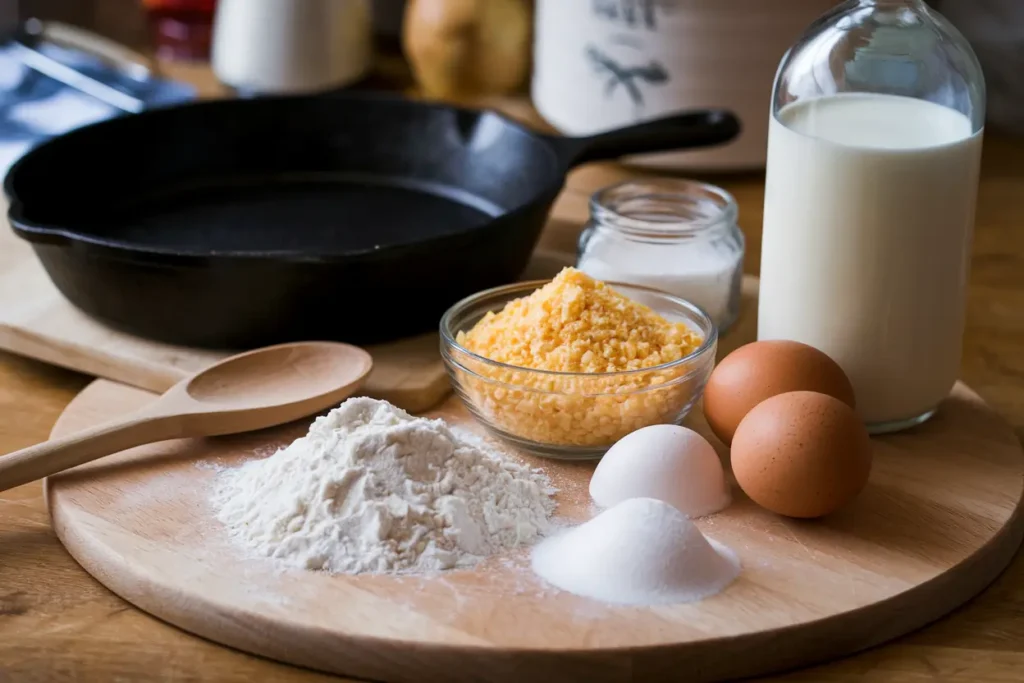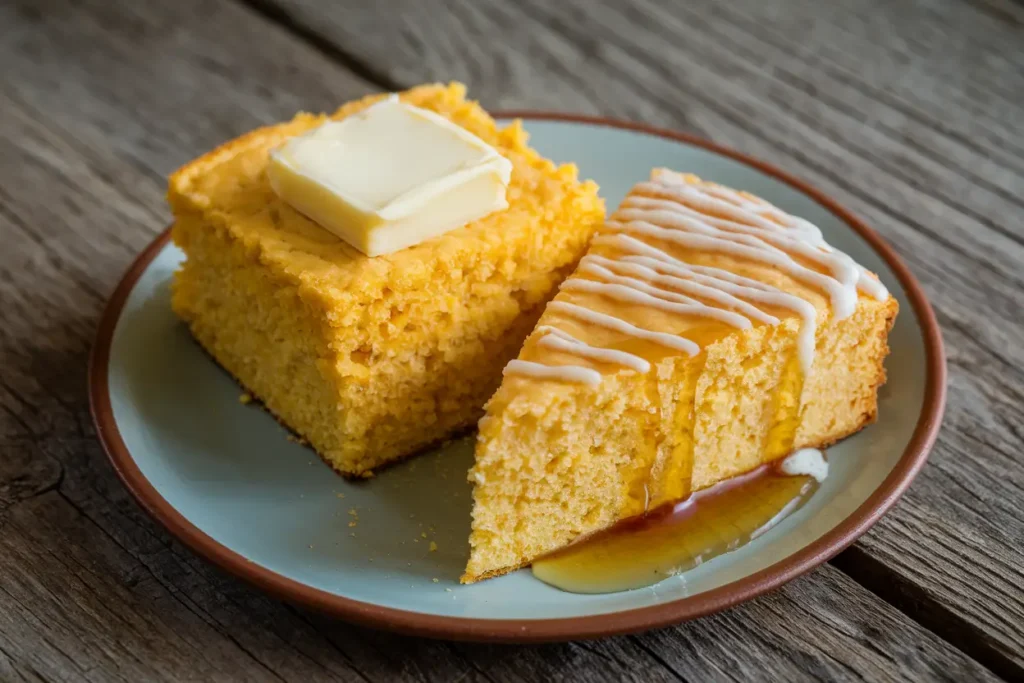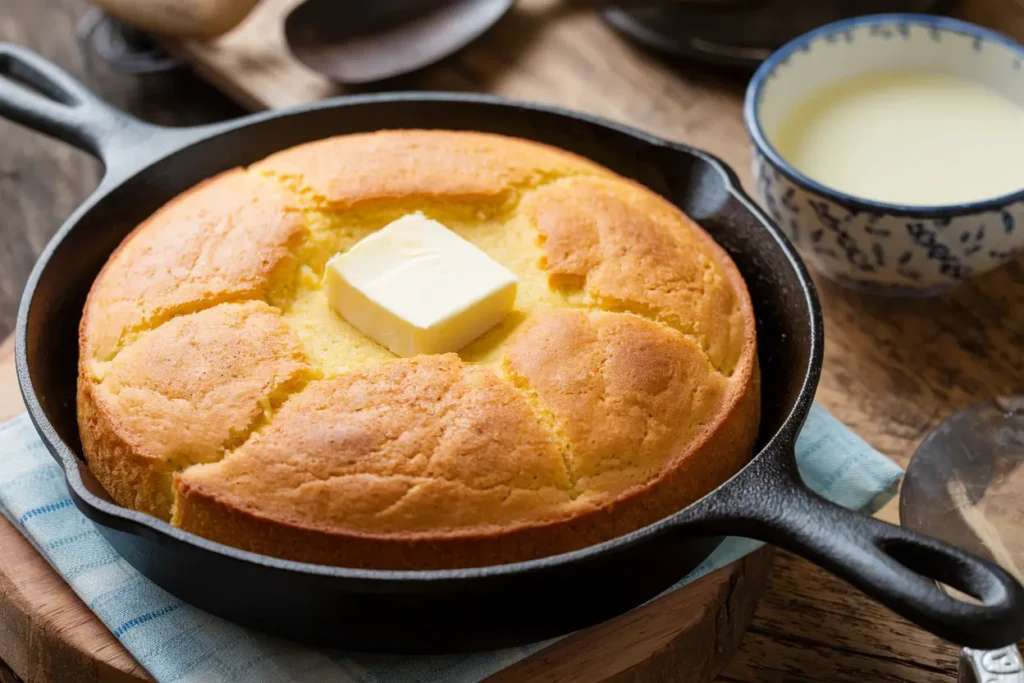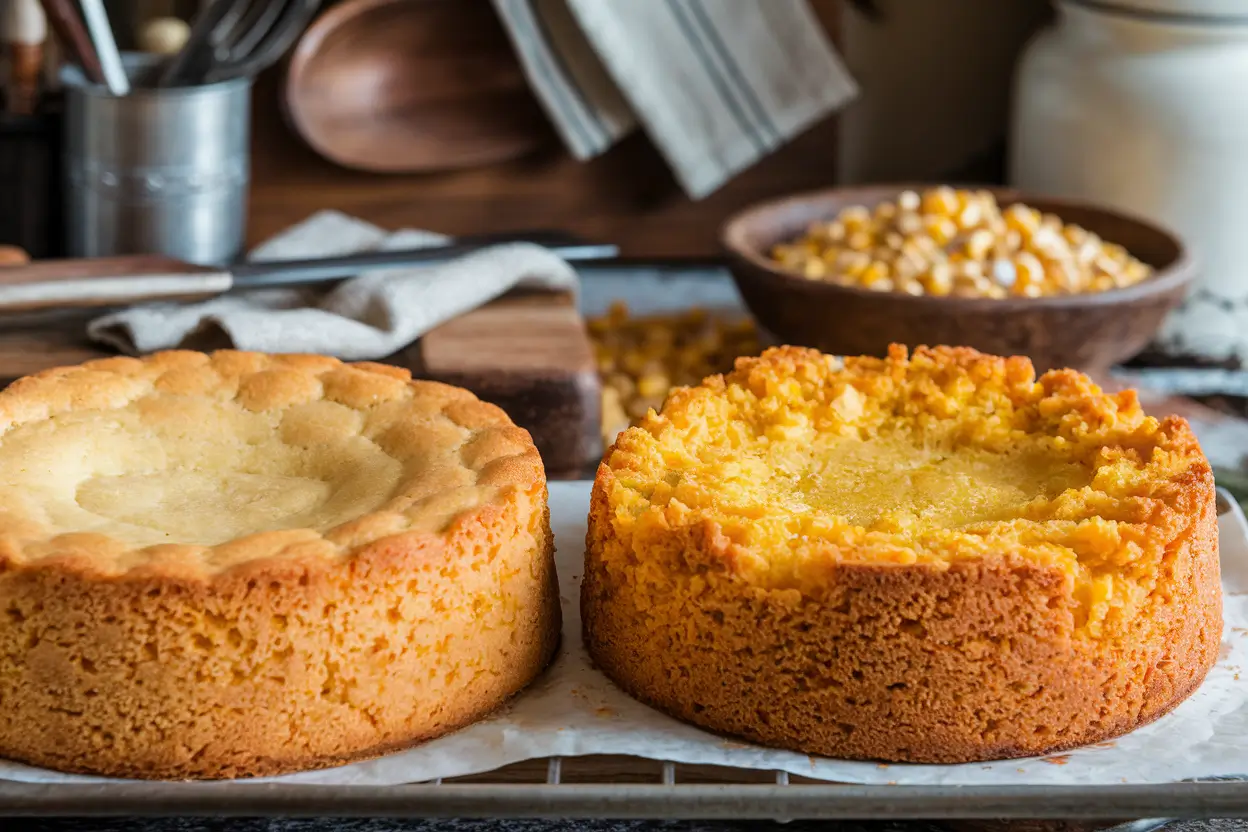Table of Contents
Cornbread is a classic American dish, but have you ever wondered what is the difference between cornbread and Southern cornbread? At first glance, these two versions may seem similar, but their unique ingredients, preparation methods, and cultural significance set them apart. Whether you prefer the sweet, cake-like texture of Northern cornbread or the savory, crumbly goodness of Southern cornbread, understanding these differences can help you choose the right version for your next meal.
Understanding the Differences Between Cornbread and Southern Cornbread
Cornbread is a type of quick bread made primarily from cornmeal, a ground version of dried corn. Its simplicity and versatility make it a favorite across various regions in the United States. Cornbread pairs beautifully with hearty stews, barbecue, or even a simple pat of butter. But when you delve deeper into this humble dish, you’ll notice stark differences between the versions crafted in the North versus the South.
Cornbread itself originated as a staple in Native American diets and evolved as settlers adapted the recipe to fit their available resources. While Northern cornbread tends to be sweeter and more cake-like, Southern cornbread is traditionally savory with a crumbly texture.
A Brief History: Cornbread vs Southern Cornbread
Cornbread has its roots in Native American cuisine, where maize was a dietary cornerstone. Indigenous people ground corn into a coarse meal and combined it with water to create simple cakes. European settlers adapted these recipes, incorporating their own ingredients and cooking techniques.
In the North, where wheat flour was more accessible, the addition of flour and sugar led to a sweeter, more delicate version of cornbread. Conversely, in the South, buttermilk and the absence of sugar became defining traits, reflecting the region’s resourcefulness and focus on hearty flavors.
How Regional Variations Define Cornbread?
As the nation expanded, so did cornbread’s variations. Northern cornbread is often baked with sugar and all-purpose flour, resulting in a light, fluffy texture. Southern cornbread, on the other hand, relies heavily on cornmeal, with little to no sugar, and is traditionally cooked in a cast iron skillet. This technique creates a crispy, golden crust that’s both visually appealing and deliciously satisfying.
Ingredients: What Sets Cornbread and Southern Cornbread Apart?

what is the difference between cornbread and Southern cornbread?
The difference in taste and texture begins with the ingredients. While the foundation—cornmeal—remains constant, the other components diverge significantly.
Cornmeal: The Foundation of Cornbread and Southern Cornbread
Cornmeal serves as the heart of any cornbread recipe. For Northern cornbread, finely ground cornmeal is often used to achieve a softer texture. In contrast, Southern cornbread calls for coarser cornmeal, lending it a heartier, crumbly consistency.
Flour vs No Flour: Key Differences Between Cornbread Styles
Northern cornbread typically incorporates all-purpose flour alongside cornmeal. This addition gives the bread its characteristic cake-like texture. Southern cornbread, however, often omits flour entirely or uses only a small amount, relying on the cornmeal to take center stage.
“Cornmeal is to cornbread what personality is to a great friend—it defines the essence!” 😊
Sugar or No Sugar? A Key Difference Between Cornbread Styles
The most debated ingredient between the two styles is sugar. Northern cornbread often includes a generous amount, making it almost dessert-like. Southern cornbread purists, however, staunchly oppose sugar, focusing instead on savory flavors enhanced by buttermilk or bacon grease.
“Adding sugar to Southern cornbread? That’s almost as controversial as putting pineapple on pizza!” 🍍
Preparation Techniques That Set Them Apart
Beyond ingredients, the methods of preparation also play a critical role in defining the two styles of cornbread.
Baking Style: Skillet vs Regular Baking Pan
Southern cornbread owes much of its identity to the cast iron skillet. Preheating the skillet before pouring in the batter creates a crispy crust that’s quintessential to the Southern style. Northern cornbread, however, is often baked in standard pans, resulting in a softer texture without the crusty edges.
Cooking Methods: How Cornbread Differs from Southern Cornbread
what is the difference between cornbread and Southern cornbread?
Southern cornbread is baked at a higher temperature to achieve its signature crust. Northern cornbread, being softer and more cake-like, is baked at a moderate temperature to retain moisture and tenderness.
Taste and Texture: What Distinguishes Cornbread from Southern Cornbread?

When it comes to flavor and texture, the contrast is unmistakable.
Sweet Northern Cornbread vs Savory Southern Cornbread
Northern cornbread’s sugar makes it sweet, while the addition of flour lightens its density. Southern cornbread, on the other hand, is deeply savory, thanks to the use of buttermilk and often bacon grease. Its texture is more crumbly and dense, perfect for soaking up sauces or pairing with hearty Southern dishes.
How Texture Reflects the Differences Between Cornbread Types?
Buttermilk is a defining ingredient in Southern cornbread, adding a tangy richness that complements the savory profile. The acidity in buttermilk also reacts with leavening agents, like baking soda, to create a tender crumb despite the lack of sugar or flour.
Why Southern Cornbread Stands Out: Cultural and Culinary Insights

Southern cornbread isn’t just a dish—it’s a cultural icon. Its unique flavor and preparation methods make it distinct from other regional variations. Let’s dive into what makes Southern cornbread shine and why it holds such a special place in Southern cuisine.
The Influence of Southern Cuisine on Cornbread
Southern food is all about bold, comforting flavors, and cornbread is no exception. It reflects the region’s agricultural roots, where corn was a staple crop. Southern cooks mastered the art of making simple ingredients shine, and cornbread became a versatile side dish that complemented everything from fried chicken to collard greens.
The use of buttermilk and bacon grease in Southern cornbread highlights the region’s penchant for incorporating rich, hearty flavors. Unlike its Northern counterpart, Southern cornbread is designed to enhance savory dishes rather than act as a standalone sweet treat.
Tradition and Cultural Significance of Southern Cornbread
what is the difference between cornbread and Southern cornbread
Cornbread in the South isn’t just food—it’s tradition. For generations, families have passed down their unique recipes, often tailored to their specific tastes. The cast iron skillet, a staple in Southern kitchens, plays a crucial role in this tradition. Seasoned over time, the skillet imparts a distinctive flavor and texture that’s impossible to replicate.
“Cornbread isn’t just made in the South; it’s celebrated. It’s like a warm hug from your grandma, straight out of the oven.” ❤️
In many Southern households, cornbread is more than just a side dish—it’s a symbol of resilience and creativity. Historically, it was a simple, inexpensive food that could feed large families during tough times. Today, it remains a cherished comfort food that brings people together.
Common Problems When Making Cornbread or Southern Cornbread
what is the difference between cornbread and Southern cornbread
Whether you’re making Northern or Southern cornbread, there are a few common pitfalls to watch out for. Let’s tackle those and learn how to create perfect cornbread every time.
Avoiding Overmixing: A Shared Pitfall in Cornbread Recipes
One of the biggest mistakes in cornbread-making is overmixing the batter. This leads to tough, dense bread instead of the desired tender crumb. The key is to mix just until the ingredients are combined—no more, no less.
Skipping the Cast Iron Skillet for Southern Cornbread
If you’re aiming for authentic Southern cornbread, the cast iron skillet is non-negotiable. It creates the golden, crispy crust that sets Southern cornbread apart. Skipping the skillet and using a regular pan will result in a softer, less authentic texture.
Not Preheating the Skillet
For Southern cornbread, preheating the skillet is a crucial step. Pouring the batter into a hot skillet ensures that the bottom develops a perfectly crispy crust. Forgetting this step often leads to soggy or unevenly cooked cornbread.
FAQs: Questions About Cornbread and Southern Cornbread Differences
Let’s address some common questions people have about cornbread and its variations.
1. Is Southern Cornbread Gluten-Free?
Yes! Traditional Southern cornbread recipes typically don’t include wheat flour, making them naturally gluten-free. This makes it a great option for those with gluten sensitivities or allergies. However, always check your recipe to ensure no flour is added.
2. Can I Make Northern Cornbread in a Skillet?
Absolutely. While Northern cornbread is usually baked in standard pans, there’s no rule against using a skillet. However, keep in mind that the texture may not be as fluffy, as the skillet promotes a denser crust.
3. Why Does Southern Cornbread Taste Savory?
Southern cornbread is savory because it traditionally omits sugar and incorporates ingredients like buttermilk and bacon grease. These elements enhance the natural flavor of the cornmeal, creating a dish that pairs well with savory Southern cuisine.
4. Can You Freeze Cornbread?
Yes, both Northern and Southern cornbread freeze well. Wrap it tightly in plastic wrap or aluminum foil before freezing. To reheat, place it in the oven to restore its texture and flavor.
5. What Is the Best Type of Cornmeal for Cornbread?
For Northern cornbread, finely ground cornmeal works best, as it creates a smoother texture. Southern cornbread benefits from coarsely ground cornmeal, which adds a hearty, rustic consistency.
6. How Do I Keep Cornbread Moist?
To keep cornbread moist, avoid overbaking it. Adding ingredients like sour cream, yogurt, or a touch of oil can also help retain moisture, especially in Northern cornbread recipes.
Choosing the Right Cornbread for Your Table
Now that we’ve explored the key differences between cornbread and Southern cornbread, the question remains: which one should you choose? The answer depends on your personal taste preferences, the occasion, and what you’re serving alongside it. Let’s break it down to help you decide.
When to Choose Northern Cornbread?
Perfect for Those with a Sweet Tooth
If you enjoy a touch of sweetness in your bread, Northern cornbread is the way to go. Its cake-like texture and mild sweetness make it a versatile side dish for both savory and sweet meals. It pairs beautifully with dishes like chili, where the sweetness can balance the heat.
Ideal for Baking Beginners
Northern cornbread recipes often require fewer steps, making them more beginner-friendly. If you’re not yet comfortable with cast iron skillets or preheating techniques, Northern cornbread baked in a standard pan is a foolproof option.
Great for Potlucks and Parties
With its lighter texture and crowd-pleasing sweetness, Northern cornbread is an excellent choice for gatherings. You can even customize it by adding ingredients like honey, cinnamon, or dried fruit to make it even more appealing.
When to Choose Southern Cornbread
The Savory Sidekick for Hearty Meals
Southern cornbread’s savory, crumbly nature makes it the perfect companion to rich, flavorful dishes like fried chicken, collard greens, or gumbo. Its texture is ideal for soaking up sauces and gravies.
For Fans of Bold Flavors
With its tangy buttermilk and optional bacon grease, Southern cornbread is packed with bold, satisfying flavors. It’s a fantastic choice for those who prefer their bread with a savory punch rather than a hint of sweetness.
When Tradition Matters?
If you’re hosting a Southern-style dinner or want to honor the heritage of classic Southern cuisine, Southern cornbread is a must. The cast iron skillet not only adds authenticity but also delivers the crispy crust that’s a hallmark of this beloved dish.
“When it comes to Southern cornbread, it’s not just food—it’s a statement of tradition and taste!” 🥘
Customizing Your Cornbread
Can’t decide between the two? Create a hybrid! By mixing elements from both Northern and Southern styles, you can craft a cornbread that suits your personal preferences. For instance:
- Add a small amount of sugar to Southern cornbread for a touch of sweetness without overpowering its savory base.
- Use a cast iron skillet to bake Northern cornbread for a crispy crust.
- Experiment with add-ins like jalapeños, cheddar cheese, or even corn kernels for a creative twist.
Cornbread and Cultural Connection
Beyond its taste, cornbread is a symbol of community, comfort, and history. Whether you’re enjoying it at a family barbecue, a Thanksgiving dinner, or a simple weeknight meal, cornbread has the power to bring people together.
Conclusion: A Tale of Two Cornbreads
The debate over cornbread versus Southern cornbread is less about competition and more about celebrating diversity. Each version offers something unique, from the sweetness of Northern cornbread to the bold flavors of its Southern counterpart.
So, the next time you’re in the mood for cornbread, think about what you’re craving and what you’ll serve alongside it. No matter which one you choose, you’re sure to enjoy a dish that’s steeped in tradition and bursting with flavor.
“Cornbread is more than a side dish; it’s a slice of history, culture, and pure comfort.”
Final Thoughts
Now that you’re equipped with the knowledge to distinguish between these two iconic cornbreads, why not try making both? Invite your friends or family for a taste test and discover which style reigns supreme in your kitchen!
For more Recipe can you clic here: https://cheifrecipes.com/baked-beans-recipe-comfort-food-youll-crave/

